1.1. The Past of OCaml#
Genealogically, OCaml comes from the line of programming languages whose grandfather is Lisp and includes other modern languages such as Clojure, F#, Haskell, and Racket.
OCaml originates from work done by Robin Milner and others at the Edinburgh Laboratory for Computer Science in Scotland. They were working on theorem provers in the late 1970s and early 1980s. Traditionally, theorem provers were implemented in languages such as Lisp. Milner kept running into the problem that the theorem provers would sometimes put incorrect “proofs” (i.e., non-proofs) together and claim that they were valid. So he tried to develop a language that only allowed you to construct valid proofs. ML, which stands for “Meta Language”, was the result of that work. The type system of ML was carefully constructed so that you could only construct valid proofs in the language. A theorem prover was then written as a program that constructed a proof. Eventually, this “Classic ML” evolved into a full-fledged programming language.
In the early ’80s, there was a schism in the ML community with the French on one side and the British and US on another. The French went on to develop CAML and later Objective CAML (OCaml) while the Brits and Americans developed Standard ML. The two dialects are quite similar. Microsoft introduced its own variant of OCaml called F# in 2005.
Milner received the Turing Award in 1991 in large part for his work on ML. The ACM website for his award includes this praise:
ML was way ahead of its time. It is built on clean and well-articulated mathematical ideas, teased apart so that they can be studied independently and relatively easily remixed and reused. ML has influenced many practical languages, including Java, Scala, and Microsoft’s F#. Indeed, no serious language designer should ignore this example of good design.
